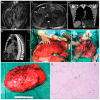Retroperitoneal Soft Tissue Sarcoma: Emerging Therapeutic Strategies
- PMID: 38001729
- PMCID: PMC10670057
- DOI: 10.3390/cancers15225469
Retroperitoneal Soft Tissue Sarcoma: Emerging Therapeutic Strategies
Abstract
Retroperitoneal soft tissue sarcoma (RPS) is a rare and heterogenous disease for which surgery is the cornerstone of treatment. However, the local recurrence rate is much higher than in soft tissue sarcoma of the extremities since wide resection is usually unfeasible in RPS due to its large size, indistinct tumour borders, anatomical constraints and the thinness of the overlying peritoneum. Local recurrence is the leading cause of death for low-grade RPS, whereas high-grade tumours are prone to distant metastases. In recent decades, the role of emerging therapeutic strategies, such as more extended surgery and (neo)adjuvant treatments to improve oncological outcome in primary localised RPS, has been extensively investigated. In this review, the recent data on the evolving multidisciplinary management of primary localised RPS are comprehensively discussed. The heterogeneity of RPS, with their different histological subtypes and biological behaviour, renders a standard therapeutic 'one-size-fits-all' approach inappropriate, and treatment should be modified according to histological type and malignancy grade. There is sufficient evidence that frontline extended surgery with compartmental resection including all ipsilateral retroperitoneal fat and liberal en bloc resection of adjacent organs and structures, even if they are not macroscopically involved, increases local tumour control in low-grade sarcoma and liposarcoma, but not in leiomyosarcoma for which complete macroscopic resection seems sufficient. Additionally, preoperative radiotherapy is not indicated for all RPSs, but seems to be beneficial in well-differentiated liposarcoma and grade I/II dedifferentiated liposarcoma, and probably in solitary fibrous tumour. Whether neoadjuvant chemotherapy is of benefit in high-grade RPS remains unclear from retrospective data and is subject of the ongoing randomised STRASS 2 trial, from which the results are eagerly awaited. Personalised, histology-tailored multimodality treatment is promising and will likely further evolve as our understanding of the molecular and genetic characteristics within RPS improves.
Keywords: chemotherapy; multimodality management; radiotherapy; retroperitoneal sarcoma; surgery.
Conflict of interest statement
The authors declare no conflict of interest.
Figures




Similar articles
-
Landmark Series: A Review of Landmark Studies in the Treatment of Primary Localized Retroperitoneal Sarcoma.Ann Surg Oncol. 2022 Nov;29(12):7297-7311. doi: 10.1245/s10434-022-12517-w. Epub 2022 Sep 10. Ann Surg Oncol. 2022. PMID: 36088426 Review.
-
Histology-tailored multidisciplinary management of primary retroperitoneal sarcomas.Eur J Surg Oncol. 2023 Jun;49(6):1061-1067. doi: 10.1016/j.ejso.2022.05.010. Epub 2022 May 16. Eur J Surg Oncol. 2023. PMID: 35599138 Review.
-
[Retroperitoneal soft tissue sarcoma: role of radiotherapy].Chirurg. 2022 Jan;93(1):34-39. doi: 10.1007/s00104-021-01498-3. Epub 2021 Sep 15. Chirurg. 2022. PMID: 34524488 Review. German.
-
Surgical Management of Retroperitoneal Sarcoma.Curr Oncol. 2023 Apr 29;30(5):4618-4631. doi: 10.3390/curroncol30050349. Curr Oncol. 2023. PMID: 37232807 Free PMC article. Review.
-
Characteristics and Outcomes of Locally Recurrent Retroperitoneal Sarcoma After First Relapse in a Single Tertiary Asian Centre and Applicability of the Sarculator.Front Oncol. 2021 Nov 25;11:730292. doi: 10.3389/fonc.2021.730292. eCollection 2021. Front Oncol. 2021. PMID: 34900680 Free PMC article.
Cited by
-
Comprehensive treatment strategy for improving surgical resection rate of retroperitoneal sarcomas: a histology-specific approach narrative review.Front Oncol. 2024 Oct 7;14:1432900. doi: 10.3389/fonc.2024.1432900. eCollection 2024. Front Oncol. 2024. PMID: 39435281 Free PMC article. Review.
-
Perioperative Systemic Therapy in Rare, Chemosensitive Subtypes of Retroperitoneal Sarcoma: A Hospital-Based Propensity Score-Matched Analysis.Cancers (Basel). 2025 Jun 10;17(12):1931. doi: 10.3390/cancers17121931. Cancers (Basel). 2025. PMID: 40563581 Free PMC article.
-
Imaging and histopathological considerations in determining the primary site and differential diagnosis of gallbladder liposarcoma.World J Surg Oncol. 2025 Jul 1;23(1):256. doi: 10.1186/s12957-025-03915-x. World J Surg Oncol. 2025. PMID: 40598262 Free PMC article.
-
Comparing epidemiological and clinical data from RPS patients documented in a German cancer registry to a cohort from TARPSWG reference centres.J Cancer Res Clin Oncol. 2024 Nov 28;150(12):514. doi: 10.1007/s00432-024-06033-5. J Cancer Res Clin Oncol. 2024. PMID: 39604531 Free PMC article.
-
Preoperative radiotherapy combined with surgery versus surgery alone for primary retroperitoneal sarcoma: a meta-analysis.Sci Rep. 2025 Jan 8;15(1):1345. doi: 10.1038/s41598-024-84636-1. Sci Rep. 2025. PMID: 39779764 Free PMC article.
References
-
- Perhavec A., Provenzano S., Baia M., Sangalli C., Morosi C., Barisella M., Colombo C., Radaelli S., Pasquali S., Callegaro D., et al. Inoperable primary retroperitoneal sarcomas: Clinical characteristics and reasons against resection at a single referral institution. Ann. Surg. Oncol. 2021;28:1151–1157. doi: 10.1245/s10434-020-08789-9. - DOI - PubMed
-
- Swallow C.J., Strauss D.C., Bonvalot S., Rutkowski P., Desai A., Gladdy R.A., Gonzalez R., Gyorki D.E., Fairweather M., van Houdt W.J., et al. Management of Primary Retroperitoneal Sarcoma (RPS) in the Adult: An Updated Consensus Approach from the Transatlantic Australasian RPS Working Group. Ann. Surg. Oncol. 2021;28:7873–7888. doi: 10.1245/s10434-021-09654-z. - DOI - PMC - PubMed
Publication types
LinkOut - more resources
Full Text Sources
Research Materials

